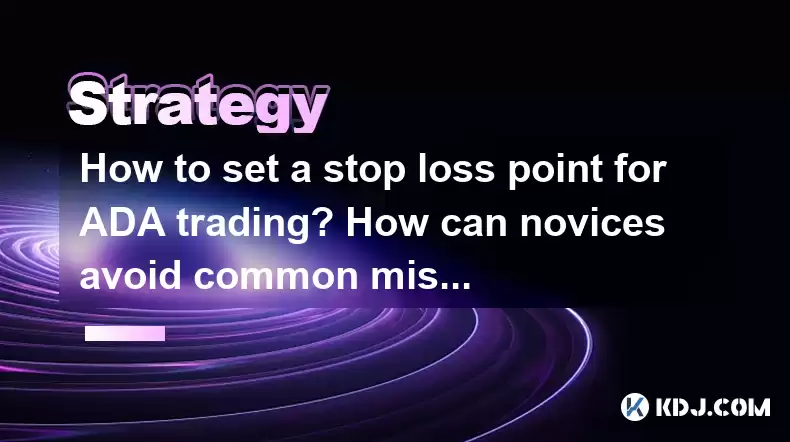-
 bitcoin
bitcoin $110918.433029 USD
-1.69% -
 ethereum
ethereum $3996.872473 USD
-2.43% -
 tether
tether $1.000594 USD
0.00% -
 bnb
bnb $1178.871834 USD
-2.38% -
 xrp
xrp $2.413973 USD
-3.47% -
 solana
solana $194.341461 USD
-4.24% -
 usd-coin
usd-coin $0.999963 USD
-0.03% -
 tron
tron $0.320092 USD
0.92% -
 dogecoin
dogecoin $0.196919 USD
-3.42% -
 cardano
cardano $0.669585 USD
-3.63% -
 hyperliquid
hyperliquid $37.485952 USD
-3.58% -
 ethena-usde
ethena-usde $1.000026 USD
-0.02% -
 chainlink
chainlink $18.018220 USD
-5.13% -
 bitcoin-cash
bitcoin-cash $523.879267 USD
-2.41% -
 stellar
stellar $0.324655 USD
-3.67%
How to set a stop loss point for ADA trading? How can novices avoid common mistakes?
Setting a stop loss for ADA trading helps manage risks; choose a platform, set a price, and confirm to limit losses effectively.
Apr 29, 2025 at 01:43 am

Trading Cardano (ADA) can be an exciting venture, but it also comes with its share of risks. One of the most effective ways to manage these risks is by setting a stop loss point. This article will guide you through the process of setting a stop loss for ADA trading and provide tips for novices to avoid common mistakes.
Understanding Stop Loss in ADA Trading
A stop loss is an order placed with a broker to buy or sell once the asset reaches a certain price. In the context of ADA trading, a stop loss order helps to limit an investor's loss on a position. When trading ADA, setting a stop loss point can prevent significant losses if the market moves against your position.
To set a stop loss for ADA, you need to determine a price level at which you are willing to exit the trade to avoid further losses. This decision should be based on your risk tolerance, trading strategy, and market analysis.
Steps to Set a Stop Loss for ADA Trading
Setting a stop loss for ADA involves a few straightforward steps. Here's how you can do it:
- Choose a Trading Platform: Select a cryptocurrency exchange that supports ADA trading and offers stop loss orders. Popular platforms like Binance, Coinbase, and Kraken are good options.
- Log into Your Account: Access your trading account on the chosen platform.
- Navigate to the ADA Trading Pair: Find the ADA trading pair you are interested in (e.g., ADA/USDT, ADA/BTC).
- Place a Trade: Decide whether you want to buy or sell ADA. If you are buying ADA, you will set a stop loss to sell if the price drops to a certain level. If you are selling ADA, you will set a stop loss to buy if the price rises to a certain level.
- Set the Stop Loss Price: Enter the price at which you want the stop loss to trigger. For example, if you buy ADA at $2.00 and want to limit your loss to 10%, you would set the stop loss at $1.80.
- Confirm the Order: Review your stop loss order and confirm it. Once placed, the order will remain active until it is triggered or canceled.
Common Mistakes Novices Make and How to Avoid Them
Novices often make mistakes that can lead to significant losses. Here are some common pitfalls and how to avoid them:
- Emotional Trading: Many beginners let emotions drive their trading decisions, leading to impulsive actions. To avoid this, stick to a well-thought-out trading plan and use tools like stop losses to manage your emotions.
- Ignoring Market Research: Trading without understanding market trends and news can be risky. Always conduct thorough research before entering a trade. Use reliable sources and stay updated on ADA's market performance.
- Overtrading: Novices often trade too frequently, trying to capitalize on small price movements. This can lead to high transaction fees and increased risk. Limit your trades to those that align with your strategy and have a clear rationale.
- Not Using Stop Losses: Failing to set stop losses is a common mistake that can result in substantial losses. Always set a stop loss for every trade to protect your investment.
Choosing the Right Stop Loss Level for ADA
Selecting the right stop loss level is crucial for effective risk management. Here are some factors to consider:
- Volatility: ADA, like many cryptocurrencies, can be highly volatile. Set your stop loss at a level that accounts for normal price fluctuations but still protects you from significant drops.
- Support and Resistance Levels: Identify key support and resistance levels on the ADA price chart. Placing your stop loss just below a support level can help avoid being stopped out by minor price movements.
- Risk-Reward Ratio: Consider the potential reward of your trade relative to the risk. A common rule of thumb is to aim for a risk-reward ratio of at least 1:2. This means if you are willing to risk $100, you should aim for a potential profit of $200.
Adjusting Stop Loss Orders
Once your stop loss order is in place, it's important to monitor and adjust it as needed. Here are some tips for managing your stop loss:
- Trailing Stop Loss: A trailing stop loss can be used to lock in profits as the price of ADA moves in your favor. This type of stop loss adjusts automatically, maintaining a set distance from the current market price.
- Reassess Market Conditions: Regularly review market conditions and ADA's performance. If the market becomes more volatile or if there are significant news events, consider adjusting your stop loss to reflect these changes.
- Move to Break-Even: Once your trade moves into profit, consider moving your stop loss to the entry price to ensure you at least break even if the market turns against you.
Practical Example of Setting a Stop Loss for ADA
Let's walk through a practical example of setting a stop loss for ADA trading:
- Scenario: You decide to buy ADA at $2.00 per coin, and you are willing to risk a 5% loss.
- Stop Loss Calculation: A 5% loss on $2.00 is $0.10, so you would set your stop loss at $1.90.
- Placing the Order: Log into your trading platform, navigate to the ADA/USDT trading pair, and place a buy order for ADA at $2.00. Then, set a stop loss order to sell at $1.90.
- Monitoring and Adjusting: As ADA's price moves, monitor the market and consider adjusting your stop loss. If ADA rises to $2.20, you might move your stop loss to $2.00 to lock in some profit.
Frequently Asked Questions
Q: Can I set a stop loss on all cryptocurrency exchanges?A: Not all cryptocurrency exchanges offer stop loss orders. Before choosing a platform, ensure it supports this feature. Popular exchanges like Binance, Coinbase, and Kraken do offer stop loss orders for ADA trading.
Q: How often should I adjust my stop loss?A: The frequency of adjusting your stop loss depends on market conditions and your trading strategy. It's a good practice to review your stop loss at least daily, especially in volatile markets, and adjust it as needed to reflect changes in ADA's price and market trends.
Q: What is the difference between a stop loss and a take profit order?A: A stop loss order is used to limit losses by automatically selling (or buying) an asset when it reaches a certain price. A take profit order, on the other hand, is used to lock in profits by automatically selling (or buying) an asset when it reaches a target price. Both are essential tools for managing risk and maximizing returns in ADA trading.
Q: Is it possible to set a stop loss too tight?A: Yes, setting a stop loss too tight can result in being stopped out of a trade due to normal market fluctuations rather than a significant price movement. It's important to balance the need to limit losses with the need to allow for some price volatility. Consider ADA's historical volatility and set your stop loss at a level that accounts for normal price movements.
Disclaimer:info@kdj.com
The information provided is not trading advice. kdj.com does not assume any responsibility for any investments made based on the information provided in this article. Cryptocurrencies are highly volatile and it is highly recommended that you invest with caution after thorough research!
If you believe that the content used on this website infringes your copyright, please contact us immediately (info@kdj.com) and we will delete it promptly.
- Uncirculated Queen Elizabeth £2 Coins: A Collector's Guide
- 2025-10-16 12:25:12
- Jimmie Bones' Battle with ALS: Kid Rock's Heartfelt Support
- 2025-10-16 12:25:12
- XRP, Ethereum, Bitcoin: Decoding the Latest Crypto Trends and Insights
- 2025-10-16 12:45:13
- Crypto Market Rollercoaster: Fear & Greed, DeFi Dips, and the Next Big Thing
- 2025-10-16 12:30:01
- Shiba Inu's Shibarium BONE Token Bridge Reopens with Enhanced Security: A New Era?
- 2025-10-16 12:45:13
- Ethereum Foundation, Morpho Protocol, and Treasury Management: A New Era of DeFi Engagement
- 2025-10-16 12:30:01
Related knowledge

Practical parameter settings for a Bitcoin multi-timeframe moving average system
Sep 18,2025 at 10:54pm
Optimizing Timeframe Combinations for Bitcoin Trading1. Selecting appropriate timeframes is crucial when building a multi-timeframe moving average sys...

How can I filter out false breakouts in Dogecoin high-frequency trading?
Sep 22,2025 at 01:00am
Understanding False Breakouts in Dogecoin Trading1. A false breakout occurs when Dogecoin's price appears to move beyond a defined support or resistan...

Techniques for identifying tops and bottoms in the Bitcoin on-chain NVT model
Sep 20,2025 at 07:54pm
Understanding the NVT Model in Bitcoin Analysis1. The Network Value to Transactions (NVT) ratio is often described as the 'P/E ratio' of the cryptocur...

What does the surge in open interest in Bitcoincoin futures mean?
Sep 20,2025 at 11:18pm
Understanding the Surge in Dogecoin Futures Open Interest1. A surge in open interest within Dogecoin futures indicates a growing number of active cont...

How can I use the Ethereum USDT premium to gauge market sentiment?
Sep 18,2025 at 11:55pm
Understanding the Ethereum USDT Premium1. The Ethereum USDT premium refers to the price difference between USDT (Tether) traded on Ethereum-based plat...

What should I do if Ethereum staking yields decline?
Sep 20,2025 at 06:18am
Understanding the Causes Behind Declining Ethereum Staking Yields1. The Ethereum network transitioned to a proof-of-stake consensus mechanism with the...

Practical parameter settings for a Bitcoin multi-timeframe moving average system
Sep 18,2025 at 10:54pm
Optimizing Timeframe Combinations for Bitcoin Trading1. Selecting appropriate timeframes is crucial when building a multi-timeframe moving average sys...

How can I filter out false breakouts in Dogecoin high-frequency trading?
Sep 22,2025 at 01:00am
Understanding False Breakouts in Dogecoin Trading1. A false breakout occurs when Dogecoin's price appears to move beyond a defined support or resistan...

Techniques for identifying tops and bottoms in the Bitcoin on-chain NVT model
Sep 20,2025 at 07:54pm
Understanding the NVT Model in Bitcoin Analysis1. The Network Value to Transactions (NVT) ratio is often described as the 'P/E ratio' of the cryptocur...

What does the surge in open interest in Bitcoincoin futures mean?
Sep 20,2025 at 11:18pm
Understanding the Surge in Dogecoin Futures Open Interest1. A surge in open interest within Dogecoin futures indicates a growing number of active cont...

How can I use the Ethereum USDT premium to gauge market sentiment?
Sep 18,2025 at 11:55pm
Understanding the Ethereum USDT Premium1. The Ethereum USDT premium refers to the price difference between USDT (Tether) traded on Ethereum-based plat...

What should I do if Ethereum staking yields decline?
Sep 20,2025 at 06:18am
Understanding the Causes Behind Declining Ethereum Staking Yields1. The Ethereum network transitioned to a proof-of-stake consensus mechanism with the...
See all articles


























![Web3 Crypto Market Morning Report: The market is in decline, altcoins have fallen by more than 5%, Binance compensation has been received, and Memes on the Bnb chain have collectively plummeted [Vic TALK Issue 1444] Web3 Crypto Market Morning Report: The market is in decline, altcoins have fallen by more than 5%, Binance compensation has been received, and Memes on the Bnb chain have collectively plummeted [Vic TALK Issue 1444]](/uploads/2025/10/16/cryptocurrencies-news/videos/web-crypto-market-morning-report-market-decline-altcoins-fallen-binance-compensation-received-memes-bnb-chain-collectively-plummeted-vic-talk-issue/68f043c9c8b44_image_500_375.webp)















































